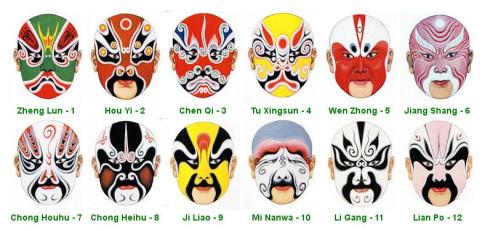Chinese opera traces its roots back to the Three Kingdoms period (or even earlier). The first formal opera troop is said to have been founded by Emperor Xuanzong who ruled China from 712 AD to 756 AD, a period which marked the apex of the Tang Dynasty. This first opera troop styled itself as “the Pear Garden” and even today Chinese opera performers describe themselves as “Disciples of the Pear Garden.”
Styles and performing conventions have changed many times in the long history of the opera as different forms have come and gone. The craft is based on mimetic gestures which express narrative actions such as horse-riding, fighting, or traveling by boat. Traditional instruments such as lutes and gongs provide a score: the libretto is sometimes sung and sometimes recited.
The most visually arresting features of Chinese opera are the bold & colorful masks worn by the performers. These masks hearken back to an ancient tradition of face-painting among warriors and, as with war paint, the colors and patterns bear symbolic meanings. The spirit and personality of each character is effectively color coded. Wikipedia nicely summarizes the meaning of each color of mask with the following handy chart (which I have copied verbatim):
White: sinister, evil, crafty, treacherous, and suspicious. Anyone wearing a white mask is usually the villain.
Green: impulsive, violent, no self restraint or self control.
Red: brave, loyal.
Black: rough, fierce, or impartial.
Yellow: ambitious, fierce, cool-headed.
Blue: steadfast, someone who is loyal and sticks to one side no matter what.
Additionally gold and silver faces represent mystery and aloofness. Of course the masks are often not real masks on stage but elaborate make-up and costuming so that the players can sing and pantomime to extravagant and wondrous effect (and so that patrons can appreciate pretty faces).




7 comments
Comments feed for this article
August 8, 2013 at 10:25 AM
SpidrGoddess
I absolutely love this art form, and it is super cool to know a little more about the masks and the information in them.
November 15, 2014 at 4:49 AM
Chinese opera in the summer palace | Travels And Pictures
[…] Can I know more about this place? […]
August 11, 2016 at 1:20 PM
Stagecraft – Black hat, White hat | PL And G Together
[…] It was in high Teochew or archaic Teochew, spoken and sung in falsetto (the better to carry their voices pre-microphone, amplifier, and electric speaker age). But it might as well have been Greek to me. But the girls, or maybe just Cheng-Cheh actually, loved the Opera and tried to educate me about the “stage craft” or code. […]
September 15, 2017 at 12:09 AM
Stan
Some of these masks look amazing!
November 2, 2017 at 12:03 PM
Chinese Opera Masks and Makeup | Charlotte Abraham Art
[…] among warriors and, as with war paint, the colors and patterns bear symbolic meanings” (ferrebeekeeper). These are more often than not elaborate designs, especially when partnered up with the costumes. […]
April 29, 2019 at 8:39 PM
fmp (12): chinese opera further research, symbolisms – tongsu 杨
[…] http://www.theatrehistory.com/asian/chinese002.html https://ferrebeekeeper.wordpress.com/2013/08/07/the-meaning-of-chinese-opera-masks/ […]
January 5, 2023 at 12:58 AM
φύλλο εργασίας – Η τέχνη στο σχολείο - Ιστολόγιο
[…] σχέδια, εμπνευστήκαμε από μερικά από τα αμέτρητα εικόνες που βρέθηκαν στον Ιστό όπως αυτήχωρίς να αντιγράψετε τις προτεινόμενες φιγούρες αλλά […]